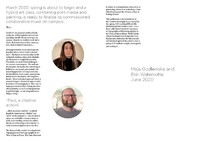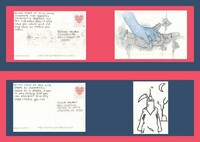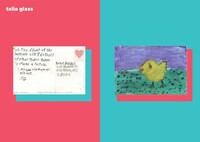From Mural to Zines
These two zines were created by students in ARTR 3162: Print Media 3: Lithography, Digital and Mixed Media and ARTP 3161: Mixed Media taught by Erik Waterkotte and Maja Kalina Godlewska. This hybrid course brought students together from various studio art programs to share and exchange ideas and skills.
Prior to the shift to online learning because of the Covid-19 pandemic, the students were working on a mural for Atkins Library. They were able to alter their focus and create to zines that are housed in Special Collections & Archives.
Project Brief from the Faculty:
Suddenly teaching from quarantine, we realized that the format and delivery of the art project needed to be adjusted in order to seriously present and share the work. We wanted students to understand that you have to consider how you're going to reach viewers if you are going to make art. If things are shut down, what formats (other than online) can be used to show and share art. As a pedagogy, Print Media includes this as it has always been an artform to involve collaboration and multiples. In lieu of a gallery or mural to feature our class's work, we turned to the printed page!
Both Topography & Psychogeography... as well as Correct Postage are directly inspired by counter-culture 1960s art of Europe and the United States. Topography & Psychogeography... was inspired by the Dérive, Guy Debord, the Situationists, and Concrete Poetry, and Correct Postage was inspired by Fluxus and Mail Art. During quarantine, we had more time which allowed the students to drift on walks and long drives, taking the time to move through the world without a particular destination and note the experience. This kind of art-making introduces students to the the politics of everyday space.
Topography and Psychogeography in the Time of Stay at Home
Topography and Psychogeography in the Time of Stay at Home
Background:
May 2020 // The theme of this creative investigation is Topography and Psychogeography in the Time of Stay at Home. This time of retreat is a time of contemplation, a time of re-experiencing, a time of re-evaluating, a time of looking beyond the obvious, a time of looking inward. // Contributing Artists: Althea Bassett, Callie Brewer, Katelyn Craig, Brianne Dameron, Sophia Dearing, Mollie Glass, Cheryl Hoke, Alfonso (Michael) Kasey, Lexi Martin, Shannon Roberson, Morgan Sharron, and Ajane Williams.
Catalogue Design by Hamilton Ward. Catalogue concept and introduction by Maja Godlewska and Erik Waterkotte.
WHAT: a creative exercise in the spirit of Psychogeography. An assigned, creative prompt, resulting in a variety of idiosyncratic actions and artifacts created during weeks of “staying at home” (limited casual walks and short-distance drives allowed). Various readings, including
HOW: observations, readings, non-verbal vs. verbal thinking, listening, smelling, daydreaming, free-association, aimless walks, drives, imaginings, investigations, journaling, mapping…
WHY: an effort to transform the obstacle of confinement into an opportunity. To paraphrase Guy Debord, an opportunity to relearn, to discover and rediscover one’s immediate environment; to reinvent and reimagine the ideas of flâneur, dérive and détournement. An opportunity to exercise the mind, to connect with our awareness, to alter our perspectives, to sharpen the senses, to contemplate details, to embrace limitations, to exercise imagination.
WHEN: late March – early May, 2020, the COVID 19 pandemic, resulting in “stay-at-home” and social distancing order issued by the state of North Carolina to flatten the curve of transmission, moving all UNC Charlotte classes online for the remainder of the semester.
Assignment Prompt
To expand on the idea of the geography and topography of Beszel and UlQoma, which we have been exploring this semester, examine your own current physical environment.
Consider objective structures, and topographies of your room, your apartment, your house, your car or the street where you go for a permitted walk.
but first
Thinking about principles of Psychogeography and Situationist Movement, please try to experience and register your surroundings in a new, unusual way. Create your own system and parameters for collecting/creating artifacts that are evidencing your experiment: perform at least 5 different actions that serve to investigate your environment in psychogeographic manner. You want to “reroute” established, ordinary ways of looking and seeing. Examples of potential actions (situations):
-
Take a bird’s-eye view of your room. Create a series of sketches imagining how it looks from the top. Or climb a ladder and look down. Superimpose with a worm’s eye-view of the same space. Establish a system in which images overlap
-
Take rubbings from your ceiling…and everything else…cut them up
-
Create a video recording of changing shadows under you bed throughout the day. Find a pattern.
-
Follow your pet for three hours and trace her movements, render on paper
-
Collect 40 different twigs in your backyard, each of them must be 3’ long
-
Create a 360-degrees panoramic-outline-drawing of your room with everything in it, inch by inch….looking around while standing but also as if spinning, suspended horizontally in mid-air
Create a documentation of your experiment, as a PDF or pptx. with photos, drawings, doodles, rubbings, hand-printed imagery, ink washes, paintings, cutouts, adding short explanations and descriptions. Be original, be inventive, unleash your imagination!
Research Sources:
Background Information
-
Guy Debord - Introduction to a Critique of Urban Geography
-
Guy Debord - Society of Spectacle
-
An Illustrated Guide to Guy Debord’s ‘The Society of the Spectacle’
-
Notes on Society of the Spectacle - Ken Knabb
-
Situationist International Collection (archive covering the movement and the idea of Détournement or rerouting/hijacking)
-
Definition of Psychogeography from the Tate Museum's Online Glossary
-
Essay on Psychogeography by Maisie Ridgway
-
History of the Flâneur from blog Psychogeographic Review which is devoted to the Art of Psychogeography
-
Guardian article "A Tribute to Female Flâneurs: The Women who Reclaimed ourCity Streets"
-
The New Republic essay "Death to the Flâneur" (about present day iterations of the flâneur concept used by exhibition curators and travel writers)
-
Exhibit "Maps as Art" at Kemper Museum of Contemporary Art (artists use maps as source of inspiration)
Other Examples
Additional Artists
-
Franz Ackerman: Dream Idea Machine and White Cube
Literature
- Xavier de Maistre - A Journey Round my Room
Documentation provided by Professor Godlewska
Read the Zine (click on Contents and then Index below to read the individual pages)
Click here for a transcription of the introduction to Topography and Psychogeography...
Print Media I: Correct Postage, A Mail...
Print Media I: Correct Postage, A Mail...
Background:
May 2020 // Taught by Erik Waterkotte, Associate Professor of Print Media. // Inspired by the 1960s art movement Fluxus, Waterkotte directed his students to study Event Scores, a form of artwork that proposes a challenge, written in just a few lines, to be completed creatively. // Contributing Artists: Robin Barnhill, Alan Boger, Christina Carsley, Kelli Crockett, Talia Glass, Emily Kinser, Jack Kozlowski, Autumn Martin, Mylek Mcneil, Stone Russell, Julius Shumpert, Katie Tonch, Danielle Walden, and Kirsten Willoughby.
Catalogue Design Hamilton Ward.
Assignment Description:
"Correct Postage and Correct Postage II are inspired by Fluxus and Mail Art. Fluxus is considered an Art Movement while Mail Art is more a method. That said, both Fluxus and Mail Art are entrenched in Populism/ anti-elitism. Both Fluxus and Mail Art are strongly connected, many Fluxus artists practiced Mail Art and celebrated Mail Artists like Ray Johnson and Genesis P. Orridge have direct connections with Fluxus. Vital to both Fluxus and Mail Art is re-examining what can be art. Students studied such practices as Fluxus Scores which were not musical but were typed directions on notecards, typically 4 lines, often vague or abstract, on how to create an artwork or performance. Fluxus artists intentionally composed their written scores without many specifics so that the scores performer would possess some agency in the artworks production as well. Students studies Fluxus scores, they performed and video recorded their own interpretations of classic Fluxus Scores by George Brecht, Allison Knowles, and Yoko Ono, and posted them on Vimeo to share. We then used Fluxus scores as a way to format the Mail Art exchange Correct Postage: students composed 3-4 postcards with scores on how to "work" the front of the card and sent these to various classmates to complete." - Professor Waterkotte
Read the Zine (click on Contents and then Index below to read the individual pages)
Click here for a transcription of the introduction to Correct Postage


































